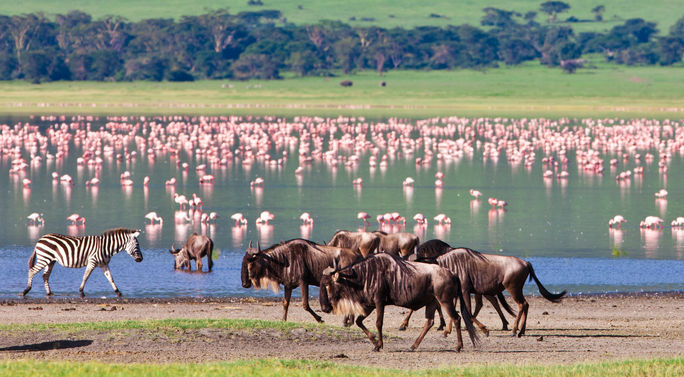We’re halfway
through the year and summer is in full swing. Vacationers from around the globe
are headed for destinations far and wide, but how do you choose which one to
settle on when they all seem so incredible?
As with so many
things in life, it may all boil down to timing. Which is why we decided to
examine which of those bucket list-worthy worldwide destinations specifically
lend themselves to a visit this August.
Where To Travel for Ecotourism
August falls in
the middle of Costa Rica’s wettest season, meaning the jungles will
be at the peak of verdancy, with lush foliage and vibrant flora. Rains still
occur briefly in the afternoon or evening, keeping the country incredibly green
and nourishing the more than 500,000 species of animals, birds and insects that
call this otherworldly paradise home. Wildlife enthusiasts will find that this
is a prime time for viewing the local fauna, as they are attracted to rivers
and watering holes.
August is also an
excellent month to explore this Central American gem because temperatures are
cooled by the frequent rains. You’ll find the highest temperatures at lower
elevations and higher humidity along the Pacific or Caribbean coasts, while
higher-elevation microclimates, such as Monteverde, are cooler and mistier.
Besides the famous Monteverde Cloud Forest, popular places to visit include the
majestic Arenal Volcano and its gateway town, La Fortuna, as well as Manuel
Antonio National Park, a Pacific coastal preserve that encompasses rugged
rainforest, white-sand beaches and coral reefs. Other destinations where you
can find breathtaking beaches alongside verdant flora include Tortuguero
National Park, one of the best places to view sea turtles (whose prime nesting
season falls in August) and Guanacaste, known as Costa Rica’s “Cold Coast”, which
has a drier climate compared to other areas of the country.
Another reason to
opt for going in August that that it’s outside of peak tourist season, meaning
that popular destinations and attractions are less crowded, making for a more
relaxed overall experience and optimal opportunities to enjoy the nation’s natural
beauty. Less tourism demand also means that pricing for accommodations, flights
and tours are often lower in August compared to the high season.

Hiker looking out at the Arenal volcano in La Fortuna (Photo Credit: Goway/Amy/ Adobe Stock)
Where To Travel in the Southern Hemisphere
Visiting Australia in August comes with several advantages, not the least of
which is the fact that it falls outside of peak tourist season (December to
February), meaning fewer crowds at popular destinations, attractions and
beaches, as well as cheaper flights, accommodations and tours. Since the Land
Down Under is in the Southern Hemisphere, August is one of its winter months,
which offers a much milder climate and a pleasant reprieve from the heat of the
Northern Hemisphere’s summer. That said,
climates vary widely across the continent, with northern regions being warmer
and drier, with average temperatures of up to 86°F, making it great for outdoor
activities like exploring the Great Barrier Reef. Meanwhile, southern regions
will be experiencing cooler weather, with an average temperature of 52°F,
according to Tourism Australia.
Over in the
well-known southern metropolis of Sydney, you can head out to the harbor for a
whale-watching tour or perhaps catch the annual City2Surf event, a 14-kilometer (8.7-mile) fun run
that attracts over 80,000 participants. Snow seekers will
find that August is prime ski season in Australia’s alpine regions, such as the
Snowy Mountains in New South Wales and the Victorian Alps. Even further south
on the island of Tasmania, visitors can head to Cradle Mountain-Lake
St Clair National Park to
hike through snow-dusted trails, look for wildlife and possibly see the southern lights along the way.

Panorama of Sydney Harbour. (Photo Credit: Goway Travel/lhboucault/Adobe Stock)
Where To Travel for Outdoor Adventures
As an equatorial
country, Colombia
is technically a year-round destination, but August is a perfect time weather-wise
to visit, boasting an average temperature of 75°F and some of the lowest
rainfall of the year. This is the dry season in many parts of the South
American country, including the major cities of Bogotá and Medellín, and the
Andes, Amazon and coffee region, making it an ideal time to enjoy some outdoor
activities, like hiking, cycling, horseback riding, wildlife watching, and
water sports and beach activities.
Over on Colombia’s
Pacific Coast—one of the wettest places on Earth, making it lush and filled
with life—August is an ideal month to visit if you want to go whale watching.
Starting in May, thousands of humpback whales begin to arrive Some of the best
spots to encounter these marine mammoths as they swim along Colombia’s 800-mile
stretch of Pacific coastline are Gorgona Island, Bahia Solano and Nuqui.
August is also a
month rife with popular festivals, such as the world-famous Feria de Flores (Festival of the Flowers) held in
Medellin—known as the City of Eternal Spring—during the first two weeks of the
month, which features an array of colorful floral displays, parades, exhibitions,
live music and other celebrations. Overall, there are 140 different cultural,
traditional and modern events that occur as part of the festival, making it a
can’t-miss attraction for anyone visiting during its 10-day run. One of the
most iconic is the Silleteros parade, where flower farmers carry elaborate
flower arrangements on their backs.

Panoramic view of Guatape, a town near Medellin, Colombia. (Photo Credit: Adobe Stock/R.M. Nunes)
Where To Travel
for Extra Daylight
Surely, it will
come as no surprise that August is an excellent time of year to visit Iceland,
as it’s one of the warmest months for the Nordic nation. The weather is mostly
mild with average temperatures of 50°F to 59°F, making outdoor activities both
more enjoyable and feasible than in the colder months. You can go take in spectacular
waterfalls and geysers, go on a glacier tour, trek highland trails, go wildlife
watching, horseback ride, dive or snorkel, soak in geothermal pools and much
more.
August is prime season for whale watching and bird watching, and you
still have the opportunity to spot some puffins as their season comes to a
close. The scenery, which is always breathtaking in some capacity, is
particularly stunning in the summer months, as landscapes are filled with vibrant
greenery and blooming wildflowers. Plus, you’ll get plenty of time in which to
sightsee or go on outdoor adventures, given that there are 16-18 hours of
daylight during this period. Since the days are still long in the Land of the Midnight
Sun, it’s not the best time of year to catch the Northern Lights. However, toward
the end of the month, the nighttime hours do start getting dark enough to see this
sought-after natural phenomenon, so your chances of seeing it start to
increase. August also brings cultural vibrancy with festivals like Reykjavik Culture Night, which
is the capital city’s birthday celebration and one of its biggest events of the
year, featuring art, music, performances and fireworks.

Blooming lupine flowers on the Stokksnes headland, Iceland. (Photo Credit: Adobe Stock/Andrew Mayovskyy)
Where To Travel
for Wildlife Spotting
If a full-fledged
African safari is on your bucket list, August is the time to go and Tanzania is
the destination to aim for. August falls within the dry season, which runs from
June to October. This means less rainfall, fewer mosquitoes and easier wildlife
spotting as animals converge around water sources. That being said, the weather
is still pleasant with days that are warm without being uncomfortably hot—generally
68°F to 86°F.
On the Serengeti, the
calendar’s eighth month sees the Great Migration in full swing. The mass
movement of millions of wildebeest, zebras, gazelles, antelope and other herd species
(and the predators that feed on them) offers an optimal opportunity for
wildlife spotting. To experience a unique microcosm of East African flora and
fauna, as well as breathtaking landscapes, head for the Ngorongoro Crater, Tarangire
or Serengeti National Park. There, wildlife sightings are abundant, including
the so-called Big Five (lion, leopard, elephant, buffalo and rhinoceros).
Meanwhile, the
coastal regions, such as Zanzibar, Pemba and Mafia Island enjoy warm and sunny
weather in August, making it an ideal time for beach activities, snorkeling,
diving and other watersports. For those with an affinity for higher altitudes, August
is one of the best months to climb Mount Kilimanjaro, since the weather is
stable, with minimal rain and clear skies, providing better views and a higher
chance of reaching the summit.

Animals at a watering hole in the Ngorongoro Crater, Tanzania.
Where To Travel
for Island Escapes
August falls in
the middle of Bora
Bora’s high season for tourism, which coincides with the dry season when
humidity is low and there is little rain. On average, year-round temperatures range
from 75°F to 84°F, but during the wet season, it’s rainier, hotter and more
humid. Although August is a popular time to visit, the South Pacific island’s exclusivity
and limited accommodation options mean it never feels overly crowded. After
all, if you’ve got a secluded overwater bungalow to yourself, it’s pretty easy
to enjoy the island tranquility.
The prime weather
during this period lends itself to outdoor activities and water sports, from
snorkeling and diving to boating, sailing and jet-skiing. An abundance of
vibrant marine life that calls Bora Bora’s coral reefs can be viewed readily
thanks to excellent underwater visibility. August also marks the start of the
whale watching season, as humpback whales migrate north from Antarctica to the
warm French
Polynesian waters to breed and calf. The dry season is also the ideal time
to tackle land-based activities, like trail hiking, ATV tours and various
excursions. Those trekking on foot often opt for the Valley of the Kings or,
for the more ambitious, Mount Otemanu, immersing themselves in the scenic beauty
of this exotic paradise filled with lush foliage and dotted with tropical
lagoons.

Bora Bora, French Polynesia. (Photo Credit: Adobe Stock/bomboman)
Where To
Travel for Cultural Events
With so many
famously remote and often frigid regions, Scotland is an ideal spot to
experience in August, which is one of the country’s warmest months with average
temperatures ranging from 50°F to 66°F. These pleasantly mild temperatures also
make August prime wildlife-watching season, as a variety of animals emerge to
soak up the warmth and enjoy summer’s bounty. On land, look for red and roe
deer, hares, squirrels and birds ranging from golden and white-tailed eagles to
capercaillie. By the sea, you might spot some puffins, seals, otters and marine
life, like dolphins and whales.
By the same token,
the Scottish countryside is at its most vibrant in August, with lush green
hills, blooming heather and clear lochs. This makes it an excellent time for
outdoor activities like hiking, cycling and exploring national parks, like the
Cairngorms, and Loch Lomond and The Trossachs. Horticultural sites, such as the
Royal Botanic Garden Edinburgh and Inverewe Garden, as well as Scotland’s many
estates are also in full bloom and at the height of their beauty during this period.
August is festival
season in Edinburgh, featuring world-renowned events such as the Edinburgh
International Festival, the Edinburgh Festival Fringe, and the Royal Edinburgh
Military Tattoo. These festivals offer a rich array of performances, from
theater and comedy to music and dance, attracting artists and visitors from
around the world. It’s also a prime month for attending traditional Highland
Games, which are held in various towns and villages across Scotland. These
events showcase traditional Scottish sports, music, and dance, offering a
uniquely rich and vivid cultural experience.
For the latest travel news, updates and deals, subscribe to the daily TravelPulse newsletter.

